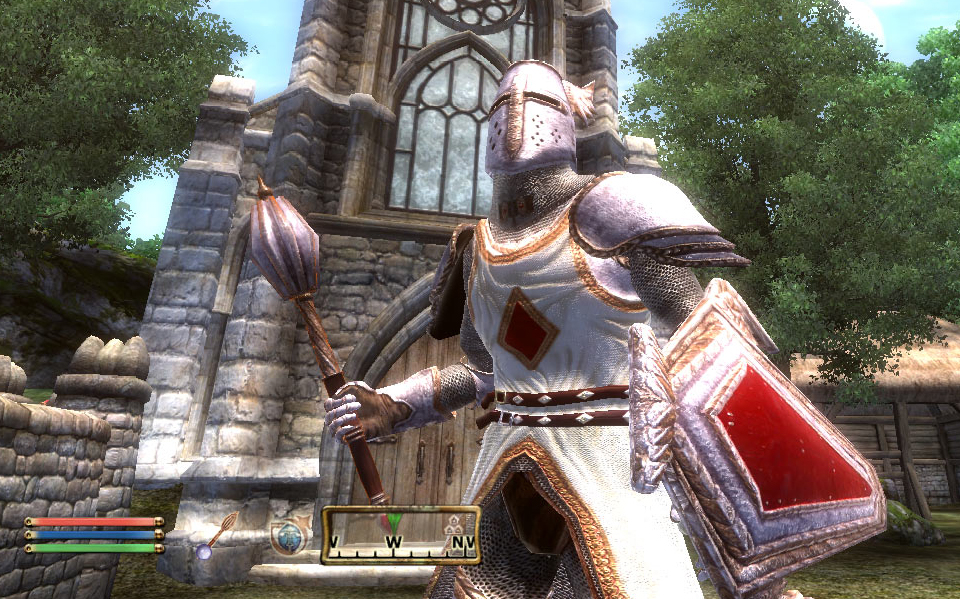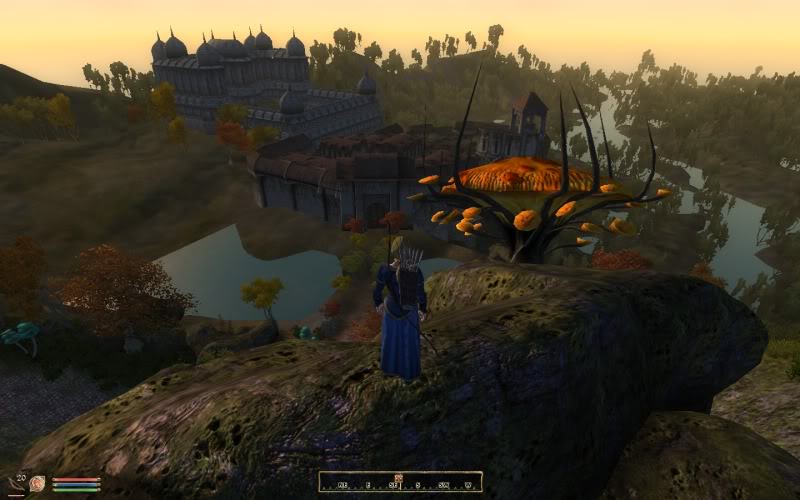The evolution of The Elder Scrolls
How The Elder Scrolls series went from gladiators to Dragonborn.

The Elder Scrolls IV: Oblivion (2006)
With Oblivion, Bethesda tried to marry what was best about Morrowind—the feeling of hand-made specificity—with the larger scope of the first two games. Using procedural generation tools, they created swathes of terrain and then edited them into shape, trees made of splines snapped to columns and algorithmic erosion roughing up the landscape.
Its setting of Cyrodiil is more than twice the size of Vvardenfell, with an extra 33 square kilometers, but with that increase in scale comes a decrease in uniqueness. As Bethesda’s Todd Howard said, “We wanted to get back to the more classic Arena and Daggerfall feel of a fantasy world that felt more refined and welcoming, a place that you instantly understood. But in that, we sacrificed some of what made Morrowind special: the wonder of discovery.”
While Oblivion begins with the hero a now-standard prisoner who is given a vital task by the Emperor, it steps back from turning you into the prophesied chosen one. Instead that role is played by Martin Septim, voiced by Sean Bean (Oblivion was the first fully voiced game in the series). Players help Martin live up to his world-changing destiny, rather than having their own. Instead, you discover your potential through sidequests. While the importance of these sidequests grew with each game, Oblivion emphasizes them to the point of feeling like a different game once you abandon the central story. Join the Thieves Guild and you eventually steal one of the Elder Scrolls themselves; join the Dark Brotherhood and you become a master assassin; hunt down the Daedric shrines and you earn artifacts of the gods.

As well as focusing on the freedom to find their own path, Oblivion emphasizes the freedom for players to explore in any compass direction. Earlier games funneled players with mountains that pushed them away from more dangerous areas, or with level limits on quests. Oblivion’s level-scaling means that no matter where you go enemies are balanced to provide an appropriate challenge.
While the intention was noble, it had strange side effects. Certain animals disappear from the land once out-leveled, and NPCs who began the game in rags carry magic swords later. Meanwhile, the arcane way character improvement works in Oblivion—with variable bonuses per level depending on whether players have been dutifully grinding to improve their lesser skills—could make one level eight hero a combat machine while another is still a wimp. It’s entirely possible for the same challenge to be harder for a higher-level character than a lower-level one.

In other ways, Oblivion reduced confusion. Morrowind players sometimes felt lost about what to do next, faced with a journal that filled itself with notes until its usefulness as a questlog vanished (the Game Of The Year edition addressed this by adding a filter for quest-related entries). In Oblivion, the journal became less messy, and an arrow points to the next objective for whichever quest is currently active. Along with the return of fast travel this infuriated the kind of fans who complain about ‘dumbing down,’ but it definitely reduced the amount of time you spent wondering where you were and what you were doing, especially if you didn’t play for several days and tried to pick up where you left off.
Oblivion was also the first Elder Scrolls game to add downloadable content, while we’re on the subject of infuriating fans. Its ‘horse armor’ selling for $2 became a running joke among critics of DLC. Later additions would be bigger and often cheaper in response, and were followed by a full-sized expansion in 2007’s Shivering Isles. Set on the island home of the god of madness, Shivering Isles replaces the fantasy European look of Cyrodiil with a twisted version of Alice In Wonderland that concept artist Adam Adamowicz memorably called “Walt Disney on steroids crapping a rainbow into your brain.” Deeply strange and small in scale, Shivering Isles recaptured Morrowind’s magic but with Oblivion’s commitment to cutting out filler.
Keep up to date with the most important stories and the best deals, as picked by the PC Gamer team.

Jody's first computer was a Commodore 64, so he remembers having to use a code wheel to play Pool of Radiance. A former music journalist who interviewed everyone from Giorgio Moroder to Trent Reznor, Jody also co-hosted Australia's first radio show about videogames, Zed Games. He's written for Rock Paper Shotgun, The Big Issue, GamesRadar, Zam, Glixel, Five Out of Ten Magazine, and Playboy.com, whose cheques with the bunny logo made for fun conversations at the bank. Jody's first article for PC Gamer was about the audio of Alien Isolation, published in 2015, and since then he's written about why Silent Hill belongs on PC, why Recettear: An Item Shop's Tale is the best fantasy shopkeeper tycoon game, and how weird Lost Ark can get. Jody edited PC Gamer Indie from 2017 to 2018, and he eventually lived up to his promise to play every Warhammer videogame.

